Vintage Guitars Info's
Rickenbacker (Rickenbacher)
Vintage Guitar Info.
Rickenbacker (Rickenbacher) vintage guitars history and collecting. Private vintage guitar collector. Pictures, history for Rickenbacker vintage guitars.
Contact the Vintage Guitar Info Guy.
1963 Rickenbacker 360-12 string
with "old" (pre-6/64) body style.
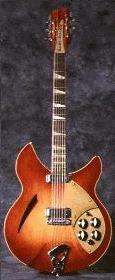
- Introduction
- General Specs
- Serial Numbers (How to Find the Year)
- Thin Hollowbody Ricks (models 310 to 375)
- Thin Fullbody Ricks (models 330f to 375f)
- Thick Hollowbody Ricks (models 381 & 385)
- Solidbody Ricks (models 400 to 1000)
- LapSteels
- Production Numbers
- Picture Gallery, Rick section
Rickenbacker Information:
Introduction.
1956 Trade show:a model with a Model 400, in pink.
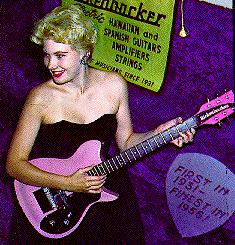
-
Rickenbacker was the first company to successfully market electric guitars.
Pre-WWII lapsteels and pre-WWII spanish models are collectible, but really
more for historic reasons than for playing. Post-WWII lapsteels are
interesting, but not to the extent of the pre-WWII models.
The most interesting Rickenbackers are the hollowbody models. In particular, the 1958 to pre-June 1964 models with the old style (squared edge) body shape, "stove" or "TV" knobs, and gold pickguard are the most interesting to me personally. The marketplace has a different idea though - The newer 1964 and later hollowbody models with checked binding and sparkle fingerboard inlays are collectible, because of their association with the Beatles, Byrds, and other 1960's super groups (though personally I don't really enjoy these newer models). The "export" models are also collectible.
-
For the most part, solidbody Rickenbacker guitars are pretty low on the
social guitar ladder. They don't really have a "sound", and haven't
played a big part in electric musically history. Therefore their values
are pretty low.
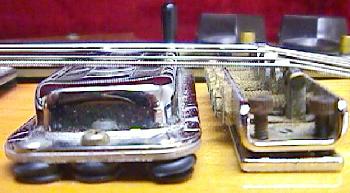
Here's the inside of a 330/340/360/370 series Rick. The body is a solid piece
of wood routed out from the back. Then a separate back is glued on. This is why
a neck set is so expensive on these guitars; you must remove the back to reset
the neck. So if the bridge has no more downward room, the Rick is essentially
trash (the cost of a neck set is often more than the value of the guitar).
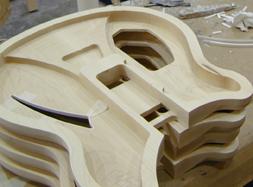
Rickenbacker painted their rosewood fingerboards with clear lacquer
(much like Fender did to their maple fingerboards). Because of this,
they can wear much like a Fender fingerboard. But the wear is much less
noticable because of the dark rosewood. This guitar is a 1960's Rick 330.
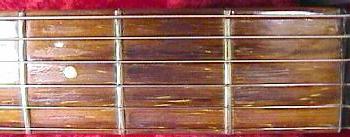
General Rickenbacker Specs.
-
Pickups
- 1932 to 1943: Horseshoe pickup, 1 1/2" wide, magnet wraps over strings.
- 1946 to 1971: Horseshoe pickup, 1 1/4" wide, magnet wraps over strings. Discontinued on most models in 1957 and replaced by the Toaster pickup. But some lapsteels still used the Horseshoe pickup until 1971.
- 1957 to 1970: "Toaster" pickup, looks like the top of a bread toaster. The classic Rickenbacker pickup that produces sound most associated with Rickenbackers.
- 1968 to 1990s: Hi-Gain pickups. Hi-Gain pickups were first introduced on the 381 model in 1968, when the 381 was reintroduced (though some early 1968 model 381 guitars did have Toaster pickups). Other models phased in these pickups in 1969 and 1970. By 1970 most models had Hi-Gain pickups.
- 1960 to present: "Rick-O-Sound" stereo (extra jack) on deluxe models (used Toaster or Hi-Gain pickups, depending on the model/year).
- 1956 to 1963: Gold back-painted clear Lucite.
- 1964 to present: Thick white plastic.
- 1958 to present: Split level pickguards on hollowbody models.
- 1956 to 1963: "TV" or "Stove" knobs, large diamond gold knobs with raised black thin center section.
- 1964 to present: Black knobs with edge indents.
Pickguards.
Knobs.
Note the "TV" knobs, gold pickguard, and
squared edge body.
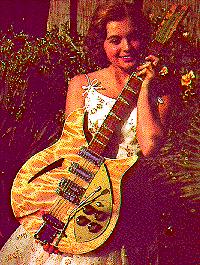
-
Trim and Fingerboard Inlays.
- Standard Trim: dot fingerboard inlays, no fingerboard binding.
- 1957 to 1970 Deluxe Trim: Triangle inlay goes completely across fingerboard.
- 1964 to 1970 Deluxe Trim: Sparkle crushed pearl fingerboard inlays.
- 1970 to present Deluxe Trim: Triangle inlay does not extend completely across fingerboard, non-sparkle inlay material.
- 1934 to 1949: "Rickenbacher" is spelled with an "h", not "k" in the "bacher" portion of the name.
- 1950 to present: "Rickenbacker" spelled with a "k".
Logo.
Rickenbacker pre-WW2 Horseshoe pickup.
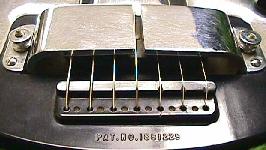
- 1956 to 1959: Yellow to brown sunburst finish.
- 1960 to present: "Fireglo" sunburst yellow to red.
- 1960 to 1980: "Autumnglo" sunburst red to brown.
- 1958 to present: "Mapleglo" natural finish.
Finishes.
Rickenbacker Serial Numbers (How to Find the Year).
Rickenbacker serial numbers are the easiest way to find the year for a particular instrument.
-
1932 to 1954 serial numbers
- Number example: #(#)C####
- Number is stamped on the jackplate or bridge.
- Numeral(s) before letter designate model: 4=400 or 425, 6=600, 65=650, 8=800.
- Letter (represented by "C" in above example) is type of instrument: C=combo (guitar), B=bass, M=mandolin, V=3/4 size.
- First numeral after letter is year.
- Last 3 numerals are number series.
- Each model has its own series.
- Example: 65C7123 = 1957 Combo 650, 4C6123 = 1956 Combo 400.
- Exceptions:
- Model 450 have 4C####A configuration.
- 3/4 size models have V###, V#### or ####A thru Oct 1960, first numeral is still last digit of year.
- Basses have B#### configuration.
- Mandolins have M### configuration.
- Some examples have #C## configuration. Dateable by serial number.
-
Serial numbers on these early models are unreliable. Some dating can be
done by patent numbers printed on the guitar. This would be the earliest
possible date of the instrument.
Solidbody Serial Numbers, 1954 to September 1959.
-
Solidbody (except 3/4 sizes) Serial Numbers, Sept 1959 to Oct 1960.
- Number configuration: #(#)A###.
- Only 3 numerals after letter. Numbers do not contain date information.
Right: The serial number on a 360. The "GD" at the top of the jack means April 1967.
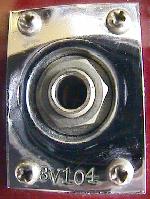
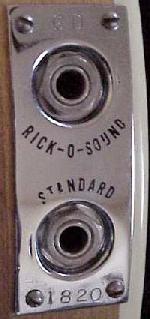
-
Hollowbody Serial Numbers, 1958 to October 1960.
- Number configuration: #A## (early 1958), or #A###.
- Numeral before letter is number of pickups (2 or 3).
- Letter (denoted by "A" in above example) is "V" for vibrato, or "T" for standard tailpiece.
- 1958 range of numbers seen: V80 to 3V254.
- Highest Capri series number in 1959: 2T835.
- First Capri series number in 1960: 3V706.
- Series (last 3 numerals) starts over with 001 in January 1960.
- Letter "R" replaces "T" or "V" on deluxe models only: June 1960.
-
Serial Numbers all models, October 1960 to 1986.
- Configuration: AA## or AA###, letters on jackplate above jack hole, numerals below jackhole.
Year First Letter Month Second Letter ---- ------------ ----- ------------- 1961 A Jan A 1962 B Feb B 1963 C Mar C 1964 D Apr D 1965 E May E 1966 F Jun F 1967 G Jul G 1968 H Aug H 1969 I Sep I 1970 J Oct J 1971 K Nov K 1972 L Dec L 1973 M 1974 N 1975 O 1976 P 1977 Q 1978 R 1979 S 1980 T 1981 U 1982 V 1983 W 1984 X 1985 Y 1986 ZSerial Number 1987 to 1991, all models.
- Configuration: A### or A####, number on jackplate, letter and 1 numeral above jack, 2 or 3 numerals below jack hole.
- Letter denotes month (see preceding table).
- Numeral after letter denotes year:
Year Numeral after letter ---- -------------------- 1987 0 1988 1 1989 2 1990 3 1991 4
Thin Hollowbody (Capri) Series, models 310 to 375.
-
Thin hollow body, double cutaway with pointed horns, both cutaways to 21st
fret, bass horn cutaway slightly longer, flat top recessed at tailpiece,
top no beveled around bass side like solidbody model with same shape,
"Cat Eye" or slash F-holes, chrome bar pickups, brown or red
sunburst or natural finish.
3/4 Full Scale
Pickups Scale Std Deluxe
------- ----- --- ------
2 pu 310 330 360
2 pu, vibrato 315 335 365
3 pu 320 340 370
3 pu, vibrato 325 345 375
Introduced in 1958, 12 3/4" wide, most with no soundholes, short 3/4 scale, 4 knobs, standard trim.
1958: Some models with "F" holes (documented, model 315 serial number 2V395) 1964: all models with "F" holes.
1963: Five knob configuration.
1975: Hi-gain pickups.
1979: No "F holes standard in 1979 (but available by special order).
- Model 310 (2 pickups, 3/4 scale) discontinued 1971, re-introduced in 1981 and discontinued 1989.
- Model 315 (2 pickups, 3/4 sale, vibrato), discontinued 1975.
- Model 325 (3 pickups, 3/4 scale, vibrato). Discontinued 1975. Model 325 re-introduced in 1984.
1966 Rickenbacker 330
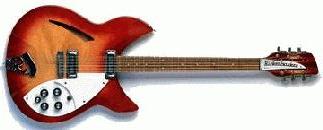
- Models 330 to 345.
Introduced in 1958, 15 1/4" wide, most with cat-eye soundholes. Dot fingerboard inlays (standard trim), back binding only or no binding, 4 knobs.
1958: Thick 2 1/2" body with square edges.
1961: Thinner body (1 1/2" deep) with square edges, no binding.
1963: Five knob configuration.
1970: Some with slanted frets.- Model 330: 2 pickups, no vibrato. Still in production today.
- Model 335: 2 pickups, vibrato. Discontinued 1978.
- Model 331 "Light Show" introduced 1970. Same as a model 330 but with "light organ" electronics and translucent plastic top and external power box. Discontinued 1975.
- Model 340: 3 pickups, no vibrato. Discontinued 1985.
- Model 345: 3 pickups, vibrato. Discontinued 1975.
1959 Rickenbacker model 360v.
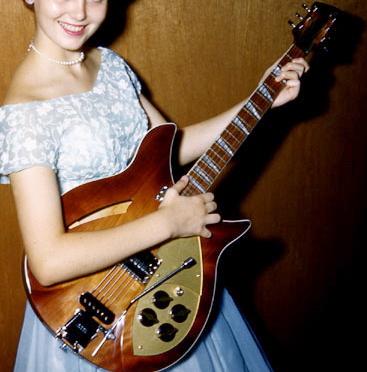
- Models 360 to 375.
Introduced 1958, 15 1/4" wide, cat-eye soundholes. Shark fin fingerboard inlays (deluxe trim), 4 knobs.
1958: "OS" (old style) thick body (2 1/2") with top and back binding, square body edges.
1960: Stereo "Rick-O-Sound" optional.
1961: Thinner body (1 1/2" deep) still with top and back binding and square body edges.
1963: "R" tailpiece on non-vibrato models and 5 knobs.
June 1964: new body style ("NS") introduced with rounded top edges, no top binding, checkered back binding, bound cat-eye sound holes. The old body style (OS) is known as "double bound", where the new body style (NS) has a rounded front body with only back binding. The knobs also change from the large TV knob to the smaller black indented knob. Pickguard changed from back-painted gold Acrylic to a solid white pickguard.
1968: Roller bridge on vibrato models 365 and 375.- Model 360: two pickups, no vibrato.
- Model 365: two pickups, vibrato.
- Model 370: three pickups, no vibrato.
- Model 375: three pickups, vibrato.
- Models 365, 375 discontinued 1975. Re-introduced in 1985.
- Export Models.
Distributed in Europe by Rose, Morris & Co, LTD.
1964: All introduced with fireglo (sunburst) finish standard.
1965: Black, autumnglo, mapleglo finish available.
1969: Last distributed by Rose, Morris.- Model 1993: export version of 330-12, but with 1 F-hole and double-bound body.
- Model 1996: export version of 325 model but with F-holes.
- Model 1997: export version of 335 model but with F-holes.
- Model 1998: export version of 345 model but with F-holes.
- Model 3262: export version of 336-12 with "comb".
- 12 String Models.
- 330-12: Twelve string version of model 330, introduced in 1965.
- 360-12: Twelve string version of model 360, introduced in 1964 with 2 pickups, "Rick-O-Sound" stereo, double bound top, bound back, bound cat-eye soundhole, bound fingerboard with triangle inlays, flat plate tailpiece. In fall 1964 new body style with rounded top edge and no top binding, checkered back binding, "R" tailpiece.
- 336-12: Twelve string version of model 330 but with a "comb" to disengage extra 6 strings, introduced 1966. Discontinued 1974.
- 366-12: Twelve string version of model 360 but with a "comb" to disengage extra 6 strings, introduced 1966. Discontinued 1974.

-
Convertible Comb 12 String Models (336/12, 366/12, 456/12).
The Rickenbacker unique string converter, commonly known as a "comb", was introduced on three models in 1966. It changed the guitar from twelve to six strings (or less than twelve strings) via a lever that pulled the desired number of the strings down against the frets (and in theory out of the way). When not engaged, the guitar is a "normal" twelve string. The comb converter was available on the 336/12, 366/12, and 456/12 (solidbody). The 336/12 was a model 330-12 with a comb. Likewise the 366/12 was a model 360-12 with a comb, and the 456/12 was a model 450-12 with a comb. The string coverter was designed by James E. Gross of Glenview, Illinois. The convertible comb models disappeared from the Rickenbacker product line in 1976 (but in reality production of this model stopped in 1974). Probably because this idea was not very good for the player. For example, strings could not be bent when the comb was engaged. So the usefulness of a combed twelve-string-made-six-string was limited at best, and certainly looked strange.
1959 Rickenbacker 330f Fullbody
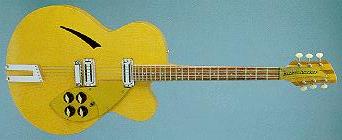
Thin Fullbody Series, models 330F to 375F.
-
17" wide, thin 2 1/2" deep, hollowbody, single rounded cutaway, controls
mounted on split-level pickguard, same
trim and feature patterns as regular model, 14 frets clear of the body,
sunburst or natural finish. Thinner body (less than 2" deep) around 1963.
Controls mounted directly to the top starting in 1969.
Introducted in 1959, all models discontinued by 1973.
Pickups Std Deluxe ------- --- ------ 2 pu 330F 360F 2 pu, vibrato 335F 365F 3 pu 340F 370F 3 pu, vibrato 345F 375F
- Model 330f, 335f only available 1959-1960.
- Model 340f, 345f discontinued 1963.
- Deluxe models 360f to 375f discontinued 1973.
Thick Hollowbody Series, models 381, 385.
-
All have full depth body and full scale.
Flattop
Pickups Archtop Roundhole
------- ------- ---------
No pu 385
2 pu 381
1936 Rickenbacker Electro Spanish Model B

Rickenbacker Solidbody Guitars
-
Pre-War Models
- Electro Spanish Model B, available 1935 to 1943.
- 1935 specs:
- Black bakelite body, horseshoe pickup, 5 chrome plates on face, 1 octagonal knob on lower bass bout, detachable bakelite neck with molded frets, string thru body.
- 1938 specs:
- 2 round knobs with ridges, one black and one white.
- 1940 specs:
- 5 plates on face now white.
- Discontinued 1943.
- Vibrola Spanish, available 1938 to 1943.
- 1938 specs:
- Black bakelite body, horseshoe pickup, 4 chrome plates on face, 6 holes on upper treble plate, motorized electric vibrola unit, 1 knob on upper bass bout and 1 on lower bass bout, detachable bakelite neck with molded frets.
- 1939 specs:
- 1 knob on lower bass bout and 1 on lower treble bout small holes in both upper bout plates.
- Discontinued 1943.
with Slight Bass-Side Cutaway.
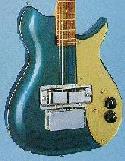
-
Cutaway Solidbody Models with Slight Bass-Side Cutaway.
- Combo 600 (single pickup) and Combo 800 (double pickup),
available 1954 to 1959.
- 1954 specs:
- Cutaway to 19th fret on treble side and to 15th fret on bass side, horseshoe pickup (double coil on 800), 1 tone switch (also selector switch on 800), 1 chrome volume knob, small black pickguard, square corner peghead, blond finish.
- 1955 specs:
- Black plastic knobs, asymmetrical peghead, vertical logo.
- 1958 specs:
- Combo 800 pickups changed to single horseshoe treble pickup and bar neck position pickup.
- Discontinued 1959, but offered in catalog with cresting wave body shape but apparently none produced.
-
Tulip (Double Cutaway) Body Shape Solidbody Models
- Combo 400, available 1956 to 1958.
- 1956 specs:
- Symmetrical tulip shaped double cutaway body, neck thru body design, 1 retangular pickup with oblong metal plate in center in neck position, tone switch on treble cutaway, 2 knobs, large anondize pickguard covers most of body but not all of pickup, Cloverfield green (blue/green), Montezuma brown (golden) or Jet Black finish.
- 1957 specs:
- Deeper cutaway on treble side, 2 switches, pickguard surrounds pickup.
- Discontinued 1958 and replaced by Model 425.
"Tulip" body shape and deeper treble cut.
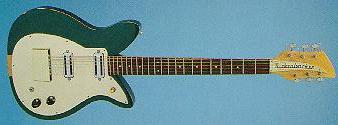
- Combo 450, available 1956 to 1958 with Tulip body shape.
- 1956 specs:
- Symmetrical tulip body shape, neck thru body design, 2 rectangular pickups with rectangular metal plate in center, 2 knobs, rotary selector switch with pointed knob on treble cutaway, Cloverfield green (blue/green), Montezuma Brown (golden), or Jet Black finish.
- 1957 specs:
- Deeper cutaway on treble side, 2 chrome bar pickups, 2 knobs and 1 selector switch on treble cutaway.
- Discontinued 1958 and replaced with Cresting wave body shape.
- Model 900 (1 pu), 950 (2 pu) and 1000 (1 pu)
3/4 size student model, tulip shaped body, neck thru body design, single pickup models have pickup in middle position, black finish, large thick white pickguard. Available 1957.
- Model 900 specs:
- 1 pickup, 21 fret neck.
- Model 950 specs:
- 2 pickups, 21 fret neck.
- Model 1000 specs:
- 1 pickup, 18 fret neck.
- Model 900, 950 went to cresting wave shape in 1969.
- Model 1000 discontinued 1971, Models 900 and 950 discontinued 1980.
- Combo 650 and 850
-
Double cutaway with pointed horns, both cutaways to 20th fret, top beveled
around bass side, 1 horseshoe pickup, natural or turquoise finish. Combo
850 has 1 double coil horseshoe pickup and 2 switches.
Available 1957 to 1959.
- 1958 specs:
- Chrome-bar pickup on Combo 650, 1 horseshoe and 1 chrome bar pickup on Combo 850.
- Discontinued 1959 but still offered in catalog till 1967.
Extreme Double Cutaway Solidbody Shape
1959 Rickenbacker Combo 450
with "Cresting Wave" body shape.
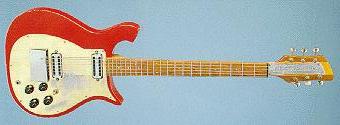
- Combo 420 and 425, available 1958 to 1984.
- 1958 specs:
- 1 5/8" thick, 1 chrome bar pickup, white thick pickguard, sunburst finish.
- 1961 specs:
- Thinner body.
- 1965 specs:
- Boyd vibrato added to Combo 425. Combo 420 introduced - same as Combo 425 but no vibrato.
- Combo 425 Discontinued 1973, Combo 420 discontinued 1984.
- Combo 450, 450-12, 456-12, available this body shape 1958 to
1984.
- 1958 specs:
- Body shape changed from Tulip to Cresting Wave shape, sunburst finish.
- 1960 specs:
- 4 knobs, fireglo, black or natural finish.
- 1961 specs:
- Thinner body.
- 1962 specs:
- Boyd vibrato added, pickguard changed from metal to thick white plastic, 3 pickups optional.
- 1964 specs:
- 12 string Combo 450-12 model available.
- 1968 specs:
- 12 string Combo 456-12 model available with comb to disengage extra 6 strings.
- 1970 specs:
- Hi-gain pickups.
- Discontinued 1984.
Cresting Wave Solidbody Shape
- Combo 460, available 1961 to 1985.
- 1961 specs:
- 2 chrome bar pickups, 5 knobs, 1 switch, deluxe trim, black, natural or fireglo finish.
- 1962 specs:
- Rick-O-Sound stereo standard.
- 1968 specs:
- Stereo discontinued.
- Discontinued 1985.
- Model 615, 625, available 1962 to 1977.
- 1962 specs:
- Top carved out around tailpiece to fix vibrato, 2 pickups, roller bridge, fireglo, natural or black finish. Model 625 has deluxe trim.
- 1964 specs:
- Adjustable height pickguard.
- Discontinued 1977.
- Model 900 (1 pu), 950 (2 pu), available 1969 to 1980 in this
body shape.
- 1969 specs:
- Cresting wave body shape replaces Tulip body.
- Discontinued 1980.
Rickenbacker LapSteels.
-
Rickenbacker Bakelite prewar lapsteels with 1 1/2" wide magnet horseshoe
pickups are considered collectible and excellent sounding instruments.
Metal body models are of little interest, except for the nickel plated
models. All postwar lapsteel models with 1 1/4" wide horseshoe magnets
have little collectability, but are fine utility instruments.
- Electro Hawaiian (Frying Pan) LapSteel A-22, A-25.
- 1932 Electro A-22 introductions specs:
- Circular cast aluminum body, horseshoe pickup, magnet 1 1/2" wide, no knobs, dot fingerboard markers, slotted peghead, "Electro" logo engraved into the peghead. The A-22 model has a 22.5" scale length, and the A-25 model has a 25" scale length.
- 1934 Electro A-22 specs:
- volume knob added, "Rickenbacher Electro" metal plate added to peghead.
- 1935 Electro A-22 specs:
- tone knob added.
- 1946 Electro A-22 specs:
- magnet 1 1/4" wide, chrome tailpiece, phillips head pickup adjustment screws.
- Electro A-22/A-25 discontinued 1950.
- A-22 Electro re-introducted 1954:
- Bakelite back plate, decal on peghead.
- A-22 Electro discontinued 1958.
- Model B and BD LapSteel.
- 1935 Model B introduction specs:
- Bakelite body and neck, horseshoe pickup, magnet 1 1/2" wide, knurled adjustment nuts on pickup, 1 octagonal knob on treble side, strings anchor thru body, 5 decorative chrome plates, bolt-on neck with integral molded frets. Can have silver or gold plated hardware (plates).
- 1937 Model B specs:
- Chicken-head Pointer knob on treble side, rounded knob on bass side.
- 1938 Model B specs:
- two round knobs with arrows, frets outlined in white, sometimes have plastic control plates.
- 1939 Model B specs:
- Knobs on same side.
- 1940 Model B specs:
- Plates painted white or black, 7 and 8 string models available.
- 1946 Model B specs:
- Magnet 1 1/4" wide, chrome tailpiece, phillips head pickup adjustment screws, metal insert in neck, T-shaped aluminum logo plate.
- 1949 Model BD specs:
- Deluxe "BD" version with metal peghead cover, available until 1970.
- 1950 Model B specs:
- "T" shaped logo plate gone.
- Model B discontinued 1955. Model BD discontinued 1970.
- Model 59 LapSteel.
- 1937 Model 59 introduction specs:
- Body stamped from sheet metal, fixed height horseshoe pickup with 2 screws on each end, 1 knob, ivory or black crinkle paint finish.
- 1938 Model 59 specs:
- 1 black knob, 1 white knob on opposite sides.
- 1939 Model 59 specs:
- shaded gray finish, much like the post-war Model NS. (Easy to confuse the two - easiest way to tell the pre-war gray sunburst Model 59 and the post-war Model NS is the width of the pickup.)
- Model 59 discontinued 1943.
- Pre-war Model NS Model 100 Silver Hawaiian LapSteel.
Known as the Silver Hawaiian or Model 100 or Model NS (new style in pre-WW2 literature). There was also a post-WW2 Model NS that has different specs.- 1937 Pre-war Model NS (100) introduction specs:
- body stamped from sheet metal (brass or nickel), nickel plated body, horseshoe pickup, 1 knob, strings attach thru holes on top.
- 1938 Pre-War Model NS (100) specs:
- two knobs on opposite sides.
- 1939 Pre-war Model NS (100) specs:
- 1 black knob, 1 white knob, knobs on same side.
- 1940 Pre-war Model NS (100) specs:
- 8 string model available.
- Model NS (100) Silver Hawaiian Discontinued 1943.
- Postwar Model NS or S LapSteel.
- 1946 Model post-war NS or S introduction specs:
- body stamped from sheet metal, height adjustable horseshoe pickup, 2 knobs, black fingerboard dots or open holes, decal logo, shaded gray finish (some crinkled), double neck available.
- 1948 Model post-war NS or S specs:
- White dot fingerboard markers, smooth finish.
- Post-war model NS or S discontinued by early 1950s.
- Model SD LapSteel (deluxe version of post-WW2 NS).
- 1949 Model SD introduction specs:
- Body stamped from sheet metal, 2 knobs, Lucite fingerboard, peghead cover, 2 tone tan/mahogany finish, 6, 7, 8 strings available.
- Model SD discontinued 1953.
- Model G (Deluxe Hawaiian) LapSteel (ornate version of pre-WW2 Silver Hawaiian).
- late 1940's Model G Deluxe Hawaiian introduction specs:
- stamped from sheet metal, chrome plated body, Lucite fingerboard back-painted gold, gold plated peghead cover, gold plated metal parts, 6 or 8 strings.
- Model G Deluxe Hawaiian discontinued 1957.
- Academy & Ace LapSteel.
- 1946 Academy introduction specs:
- Bakelite body, horseshoe pickup, 2 knobs, "Academy" on peghead or "Ace" on peghead, brown mahogany or maroon or blue or white finish.
- Academy discontinued 1948 and Ace introduced
with "Ace" on peghead.
- Ace discontinued 1953.
Rickenbacker Frying Pan Electro A-22 LapSteel

1940 Rickenbacker Model B Lapsteel (bakelite)
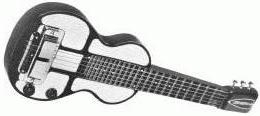
1935 Rick Model B lapsteel.
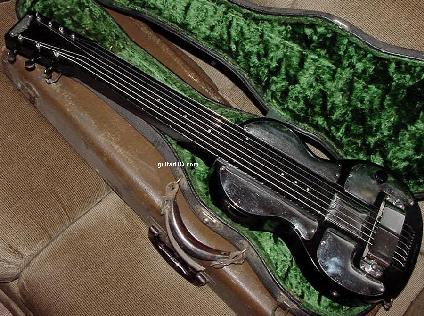
1937 Rick model 59 lapsteel.
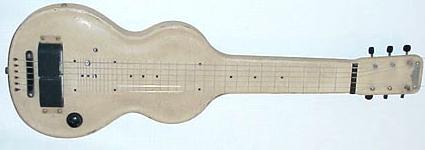
1937 Rick NS Model 100 Silver Hawaiian.
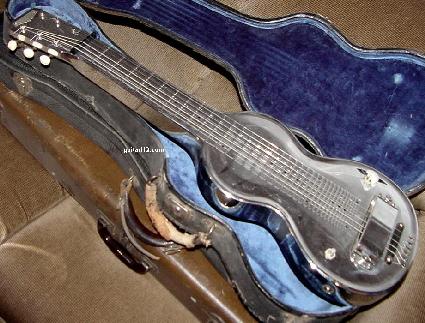
1946 post-WW2 Rick Model NS or S lapsteel.
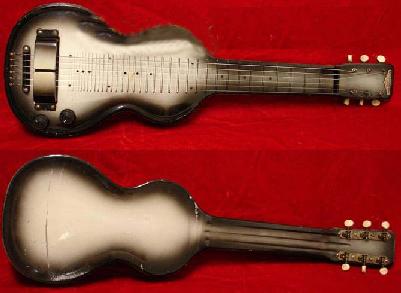
1949 Rick Model G Deluxe Hawaiian.
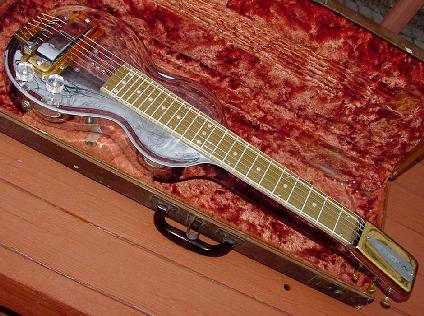
Rick Academy lapsteel.
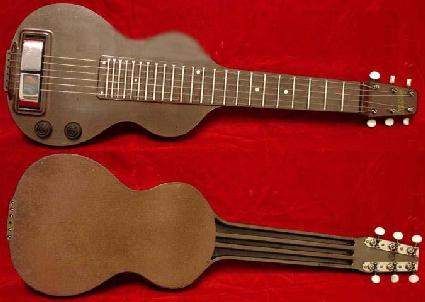
(serial number V81) is JOHN LENON's actual guitar (or what
would soon be his actual guitar, John later repainted it
black). Yes the trade show had his guitar, before John
bought it. Oh the sins musicians do to their instruments...
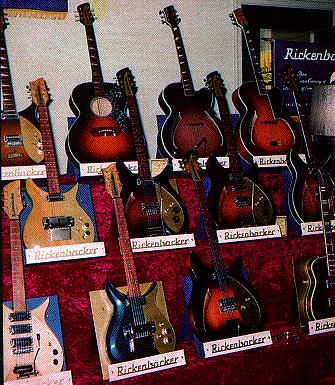
Rickenbacker Production Numbers, 1958-1966.
-
These totals are from Rickenbacker factory invoices and published
by Richard Smith in his Rickenbacker book (see my bibliography
web page). Since some samples
did not have invoices, so these instruments were not counted in the
following numbers. Invoices for 1967 and the first two months of
1968 are not available, as they could not be found. Hence this list
stops at 1966. IMPORTANT NOTE: These production numbers are *not*
accurate. They do give some idea of Rickenbacker's production during
the 1960s, but these numbers are definately not accurate. Real
production is greater than these numbers indicate.
- NS = new style body (rounded edges).
- OS = old style body (square edges).
- /12 = 12 string model.
The following abbreviations are used. If there is no color designation, then the color produced was unknown.
| Model | 1958 | 1959 | 1960 | 1961 | 1962 | 1963 | 1964 | 1965 | 1966 | Total |
|---|---|---|---|---|---|---|---|---|---|---|
| 320 | . | . | . | . | . | . | . | . | 4 | 4 |
| 325 | 28 | . | 1 | . | . | . | 25 | 2 | 40 | 96 |
| 330 | 16 | 40 | 22 | 11 | 1 | 5 | 32 | 63 | 264 | 454 |
| 330/12 | . | . | . | . | . | . | 1 | 22 | 392 | 415 |
| 335 | 49 | 49 | 24 | 9 | 2 | 8 | 22 | 49 | 442 | 624 |
| 340 | 1 | . | . | . | . | 1 | . | . | . | 2 |
| 345 | 24 | 29 | 44 | 21 | 2 | . | 2 | 9 | 128 | 250 |
| 360 OS | 14 | 96 | 60 | 26 | 1 | 6 | . | 4 | 1 | 208 |
| 360 NS | . | . | . | . | . | . | 7 | 96 | 262 | 365 |
| 360/12 OS | . | . | . | . | . | 2 | 5 | 29 | . | 36 |
| 360/12 NS | . | . | . | . | . | . | 36 | 480 | 1164 | 1680 |
| 365 OS | 37 | 90 | 75 | 79 | 44 | 37 | 4 | 19 | 70 | 455 |
| 365 NS | . | . | . | . | . | . | 67 | 127 | 622 | 816 |
| 370 OS | . | 4 | . | 3 | . | . | . | . | . | 7 |
| 370 NS | . | . | . | . | . | . | . | . | 6 | 6 |
| 370/12 NS | . | . | . | . | . | . | . | . | 5 | 5 |
| 375 OS | 1 | 9 | 7 | 9 | 6 | 8 | . | 1 | . | 41 |
| 375 NS | . | . | . | . | . | . | 11 | 16 | 74 | 101 |
| Model | 1958 | 1959 | 1960 | 1961 | 1962 | 1963 | 1964 | 1965 | 1966 | Total |
The are NOT accurate, but do give some general idea
on the number of guitars made during this period.
Contact the vintage guitar info guy
Back to the Top
Back to the Table of Contents
Copyright 1995-2002 all rights reserved.